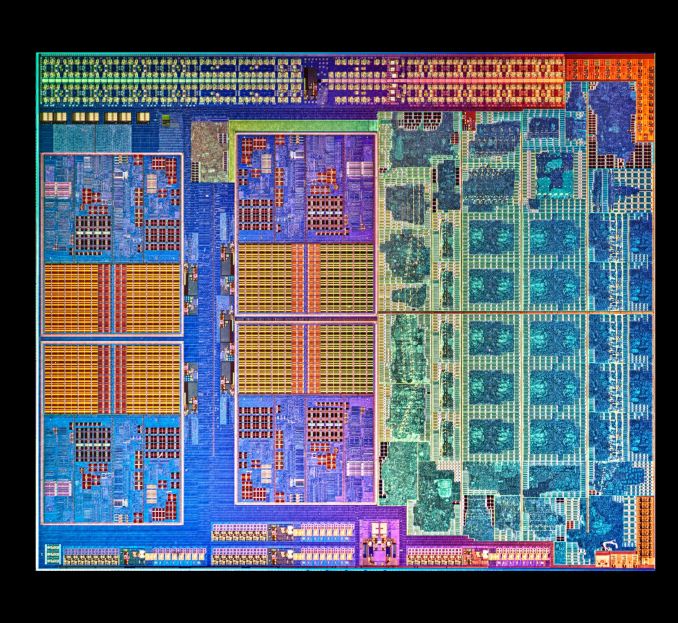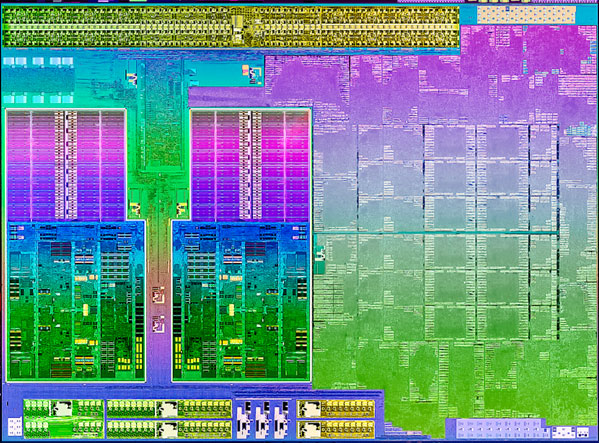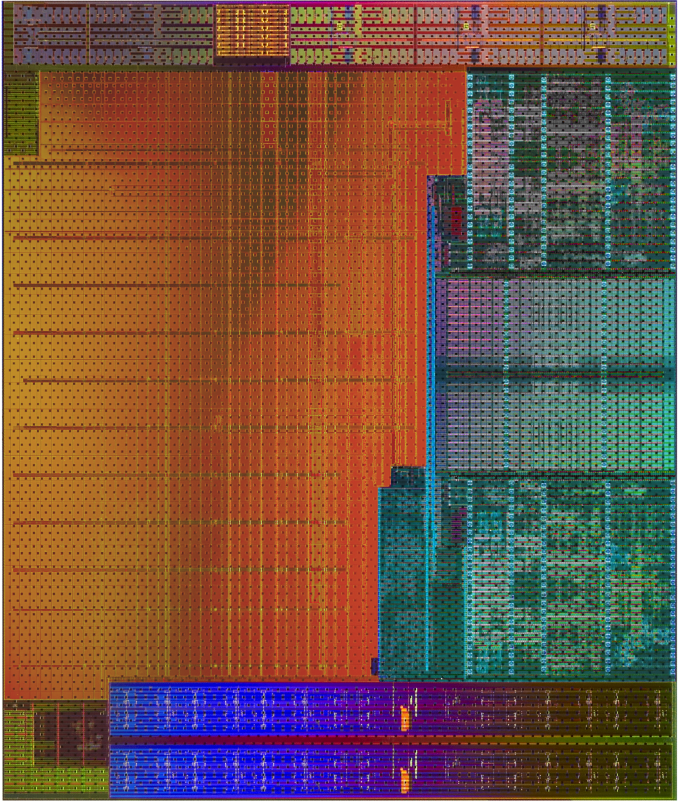AMD Kaveri Review: A8-7600 and A10-7850K Tested
by Ian Cutress & Rahul Garg on January 14, 2014 8:00 AM ESTLlano, Trinity and Kaveri Die: Compared
AMD sent along a high res shot of Kaveri's die. Armed with the same from the previous two generations, we can get a decent idea of the progression of AMD's APUs:
Llano, K10 Quad Core
Trinity and Richland Die, with two Piledriver modules and processor graphics
Kaveri, two modules and processor graphics
Moving from Llano to Trinity, we have the reduction from a fully-fledged quad core system to the dual module layout AMD is keeping with its APU range. Moving from Richland to Kaveri is actually a bigger step than one might imagine:
| AMD APU Details | ||||
| Core Name | Llano | Trinity | Richland | Kaveri |
| Microarch | K10 | Piledriver | Piledriver | Steamroller |
| CPU Example | A8-3850 | A10-5800K | A10-6800K | A10-7850K |
| Threads | 4 | 4 | 4 | 4 |
| Cores | 4 | 2 | 2 | 2 |
| GPU | HD 6550 | HD 7660D | HD 8670D | R7 |
| GPU Arch | VLIW5 | VLIW4 | VLIW4 | GCN 1.1 |
| GPU Cores | 400 | 384 | 384 | 512 |
| Die size / mm2 | 228 | 246 | 246 | 245 |
| Transistors | 1.178 B | 1.303 B | 1.303 B | 2.41 B |
| Power | 100W | 100W | 100W | 95W |
| CPU MHz | 2900 | 3800 | 4100 | 3700 |
| CPU Turbo | N/A | 4200 | 4400 | 4000 |
| L1 Cache |
256KB C$ 256KB D$ |
128KB C$ 64KB D$ |
128KB C$ 64KB D$ |
192KB C$ 64KB D$ |
| L2 Cache | 4 x 1MB | 2 x 2 MB | 2 x 2 MB | 2 x 2 MB |
| Node | 32nm SOI | 32nm SOI | 32nm SOI | 28nm SHP |
| Memory | DDR-1866 | DDR-1866 | DDR-2133 | DDR-2133 |
Looking back at Llano and Trinity/Richland, it's very clear that AMD's APUs on GF's 32nm SOI process had a real issue with transistor density. The table below attempts to put everything in perspective but keep in mind that, outside of Intel, no one does a good job of documenting how they are counting (estimating) transistors. My only hope is AMD's transistor counting methods are consistent across CPU and GPU, although that alone may be wishful thinking:
| Transistor Density Comparison | ||||||||
| Manufacturing Process | Transistor Count | Die Size | Transistors per mm2 | |||||
| AMD Kaveri | GF 28nm SHP | 2.41B | 245 mm2 | 9.837M | ||||
| AMD Richland | GF 32nm SOI | 1.30B | 246 mm2 | 5.285M | ||||
| AMD Llano | GF 32nm SOI | 1.178B | 228 mm2 | 5.166M | ||||
| AMD Bonaire (R7 260X) | TSMC 28nm | 2.08B | 160 mm2 | 13.000M | ||||
| AMD Pitcairn (R7 270/270X) | TSMC 28nm | 2.80B | 212 mm2 | 13.209M | ||||
| AMD Vishera (FX-8350) | GF 32nm SOI | 1.2B | 315 mm2 | 3.810M | ||||
| Intel Haswell 4C (GT2) | Intel 22nm | 1.40B | 177 mm2 | 7.910M | ||||
| NVIDIA GK106 (GTX 660) | TSMC 28nm | 2.54B | 214 mm2 | 11.869M | ||||
If AMD is indeed counting the same way across APUs/GPUs, the move to Kaveri doesn't look all that extreme but rather a good point in between previous APUs and other AMD GCN GPUs. Compared to standalone CPU architectures from AMD, it's clear that the APUs are far more dense thanks to big portions of their die being occupied by a GPU.













380 Comments
View All Comments
Calinou__ - Saturday, January 25, 2014 - link
The consoles use lower level APIs, way more optimized.dsmogor - Friday, January 24, 2014 - link
From a distance the Amd architecture actually looks a lot like PS3 Cell SOC: number of CPU cores + VLIV modules that access the same bus and memory. If the GPU cores have some sort of manageable local memory (dunno) I clearly see why Sony have choosen that for their next gen.Houdhaifa - Saturday, January 25, 2014 - link
nice performanceTheyear - Sunday, January 26, 2014 - link
hixtremesv - Tuesday, January 28, 2014 - link
I'd rather give your grandpa a FX-4300 + GT640 GDDR5 roughly for the same price as A10-7850K and even better, for $20 more you ditch the FX-4300 for a FX-8120.thomascheng - Tuesday, January 28, 2014 - link
You can get the 7850K from Microcenter for 129.00 right now, its only for a limited time. I think I'll bite at the price point.neal.a.nelson - Tuesday, January 28, 2014 - link
No, that's the 6800K. The 7850K isn't even on the main AMD page.The AMD A10-7700K Unlocked Black Edition
10 Computer Cores (4 CPU + 6 GPU)
Features AMD Radeon™ R7 Graphics
AMD TrueAudio Technology for immersive audio 9
AMD A10-7700K
$159.99
REG. $179.99 045013
Buy Now!
BUNDLE & SAVE!
AMD A10-6800K
$129.99
REG. $159.99 617795
Buy Now!
BUNDLE & SAVE!
rrgg - Sunday, February 2, 2014 - link
Is there a stated release date for the A8-7600 (Kaveri)? I know it was pushed out but to when? Thanks.Novaguy - Wednesday, February 12, 2014 - link
Hmmm, any news about the a8-7600 availability? Or mobile parts?What I am really curious about is the performance of a kaveri a8 + r9-290m (aka 7970m/8970m rebadge) in a laptop (such as the msi model that was reviewed on anandtech). Will that get of the frame throttling that was going on in that msi laptop?
DoctorBurp - Thursday, February 20, 2014 - link
It is interesting to see how computers involved into having two “brains”: The CPU which works sequentially and is generally better with small amount of data, and the GPU which works parallel and is generally better with large amount of data.Us humans also tend to have two ways of thinking, and to demonstrate it let us talk about decisions making. When dealing with small amount of information we tend to take the sequential route: We investigate, write notes , explorer in depth and operate in a step by step manner it order to make the right choice. However when dealing with large amount of information it is impossible to remember each and every detail and investigating turns to be a tedious work. This is when we turn to our gut feeling, our intuition, and at the end make a decision because it “feels right”. This feeling is a result of a processing which took place backstage in areas like our sub subconscious, which as far as we know it works in a parallel way.
Since computers have been invented by humans, and for the most part reflect the way WE think, it is not surprising to find these similarities. I for instance find it fascinating and funny at the same time :) Maybe by trying to imitate the way we think we will end up understanding our self better…
Just thought of sharing it with you all.